Message match: the #1 reason why your B2B SaaS needs landing pages
Have you ever Googled something, clicked on a link, and got very confused about the landing page?
Of course, you have! It happens all the time.
We call it a bad message match.
Message match tells how closely the landing page copy and visuals match our search keyword and the Google ad content: a headline, description, URL, add-ons, and image. In addition to Google Ads, you’ll experience message matches when clicking links on newsletters, social media posts, blog posts, and any other marketing messages.
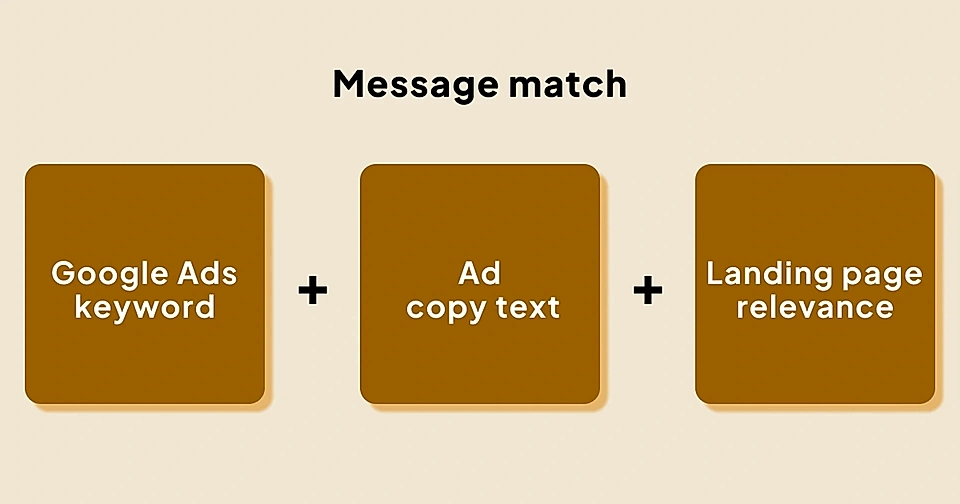
The better the message match, the more closely the content matches the user’s expectations, and the higher your landing page conversion rates.
In B2B, the multi-step buyer journey and the amount of decision-makers mean that optimizing message match is quite a bit more challenging than in B2C.
While a B2C webshop will also need to serve the right page matching the customer’s intent, many purchases are completed based on intuition and buying decisions are made alone or as a couple. In B2B, you might need to convince teams from engineering to top leadership to even get a demo call booked.
But before we discuss challenges specific to B2B SaaS and how AI can improve message match, let’s look at a few good and bad examples of message matching.
Good and bad message match examples
It’s not difficult to find good and bad message match examples – only 30% of Google Ads have a great message match.
In fact, it took me a single Google search and a couple of refreshes to get you a representative collection to show.
Bad message match examples
I decided to Google “mind mapping tool”, and Asana’s ad immediately showed up.
The headline says: “A Smarter Way to Work - Asana: Easy to Adopt and Use”.
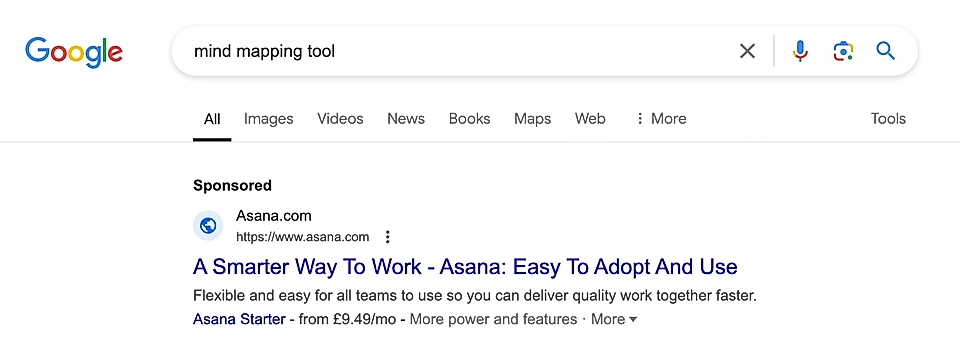
There are other issues in the ad copy as well, but clearly, the text doesn’t mention “mind mapping tool” or any similar phrase. However, I’m familiar with the brand – I have used their product in the past – and I decided to click on their ad.
The landing page copy text introduces a Gantt chart tool that helps you to create a graphical representation against time.
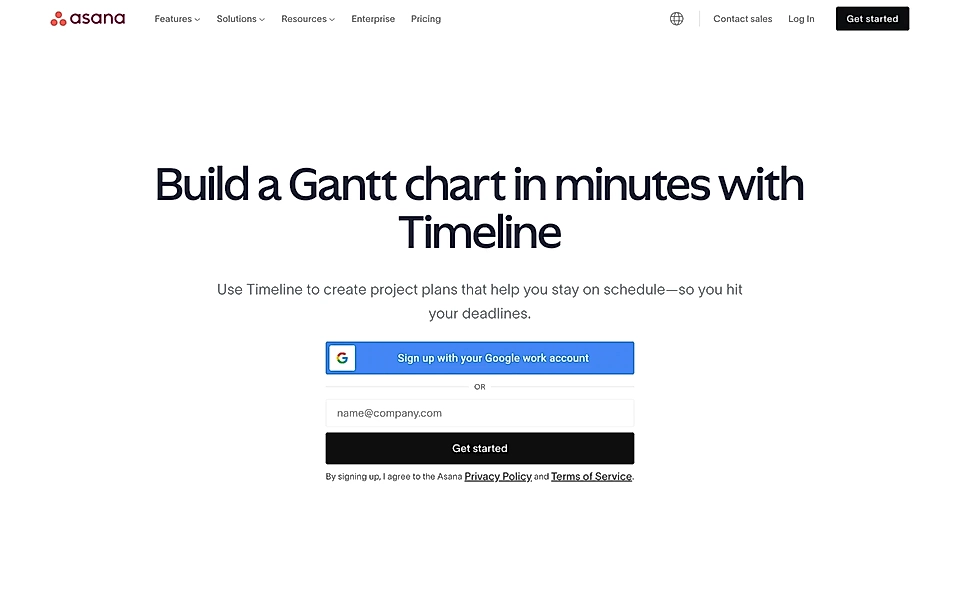
Asana’s marketing team is clearly wasting money here. I say no thank you and hit the back button.
Let’s take a look at another example.
Figma’s Google ad headline is “Brainstorm Mind Map”.

Although I didn’t expect anything mentioning “brainstorm”, compared to Asana, I’m feeling pretty good about this ad. The ad mentions "mind map" and visualizing capabilities.
But what a shock it was to land on Figma’s canvas.
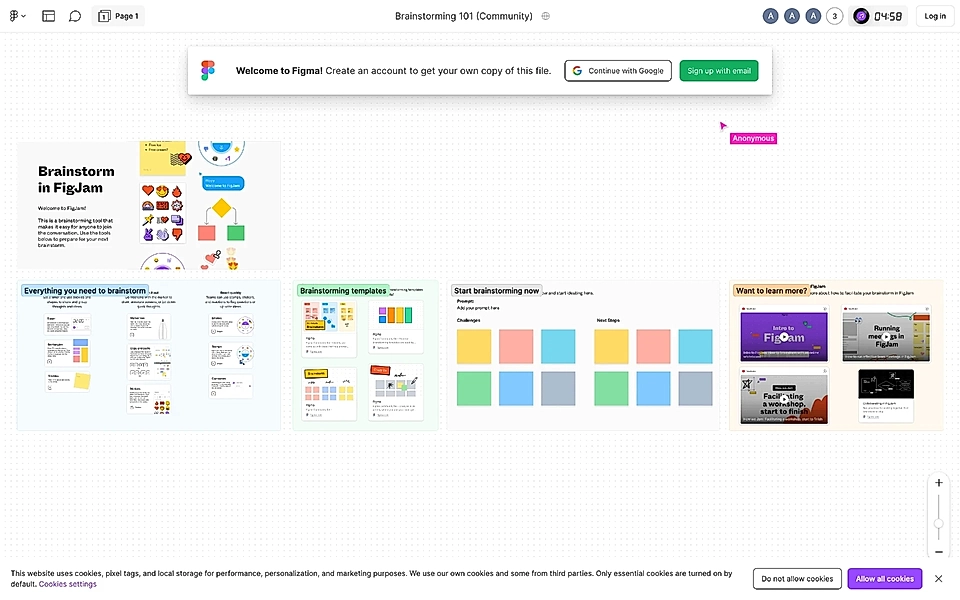
Unless I had been familiar with Figma’s brand and main product, I would not stay on the page for more than a couple of seconds. Now, I stay a moment in awe – I bet most people won’t bother zooming in and out to investigate further.
Average message match example
After the first two clicks, I hit refresh and found Figma again.
Interestingly, Figma runs a second ad copy and uses a different Google Ads landing page for the same search term.
Now, the headline is an even closer match, saying “Mind Map Online” instead of “Brainstorm”.

Compared to the previous ad copy, the description is now a bit off-target, promoting a whiteboard. However, the overall ad copy text is tempting, and I decided to give Figma a second chance.
The landing page is much better than the canvas I found previously.
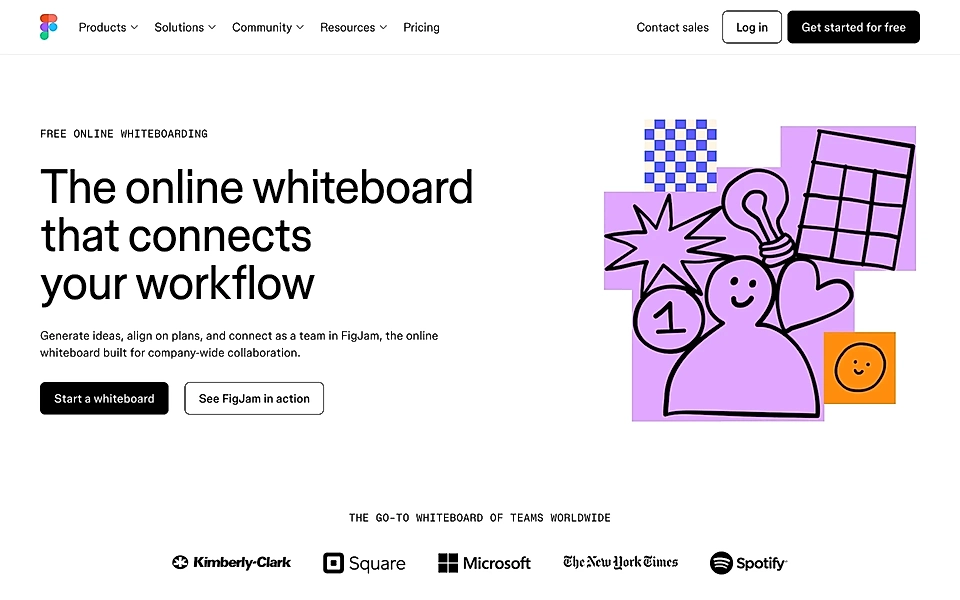
However, this page fails to mention "mind map" and is clearly built for their product feature called “Whiteboard”. I would have preferred a product image, and the illustrations leave me a bit confused.
If a user is not in a hurry, they might stay on the page and figure out whether whiteboard capabilities are pretty similar to mind mapping tools. Most users will leave this page quickly, though.
Good message match example
Finally, it’s time to show the good message match example.
Lucidchart’s ad headline says “Online Mind Map Maker” – that’s a very close match to a “mind mapping tool”.

The ad uses actionable verbs like make, get, and use, which increase the clickthrough rate.
The visual layout of the page hero isn’t the best possible, but we’ve got a closely matching title (Mind map software) and an image clearly showing that Lucidchart provides a mind mapping tool. I’ve finally found a PPC landing page example where I happily continue scrolling beyond the landing page hero section.
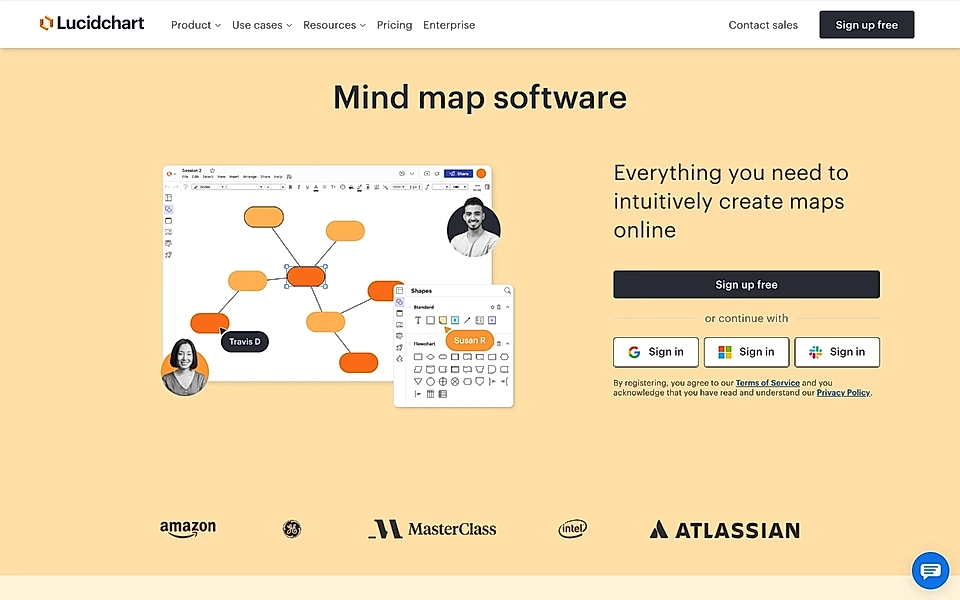
As you can tell from examples, having a large marketing team and big budgets don’t necessarily guarantee success. To avoid wasting money on paid advertising and to get the message match right, your B2B SaaS needs a lot of landing pages matching various search phrases and user intents.
Is your SaaS team getting new pages done fast? If not, LandingRabbit can help. Sign up for our 14-day free trial today to plan and publish SaaS landing pages without the back-and-forth and guesswork.
What makes message match challenging in B2B SaaS?
I briefly mentioned that B2B SaaS marketing and message match come with challenges that you might not experience in the consumer marketing world.
Message match is challenging in B2B SaaS because:
- Growing SaaS businesses have many value propositions.
- The buyer journey isn’t often linear.
- User intents are more complex and multi-sided.
- Remarketing isn’t as straightforward as in B2C
- The B2B buying process often involves many decision-makers.
Let’s take a look at each challenge separately.
1. Many value propositions

I could have said ‘many products’, but that would have been misleading. It’s not that simple, I’m afraid.
While buying everyday products as a customer is straightforward, and you’ve got a pretty clear idea of what you get by holding the product in your hands, a B2B SaaS product can be bought for many use cases.
Perhaps you are selling software like Equals, which targets anyone in a startup that hits the wall with Excel’s capabilities.
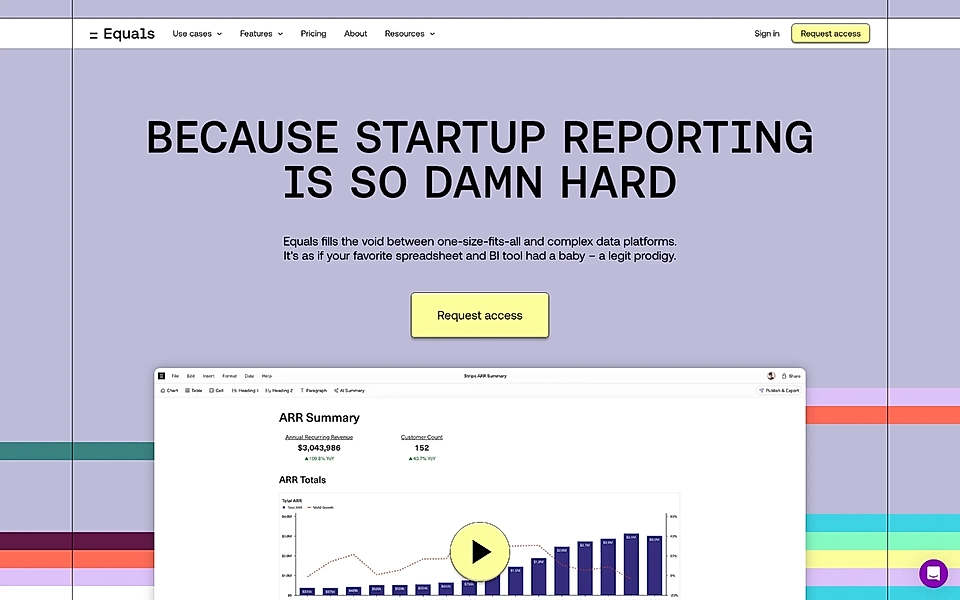
Their ideal customer can be a financial team member who’s looking to keep the MRR growth numbers up-to-date automatically and avoid copy and paste.
Or a marketing team member who wants to pull in social media data to an Excel-like tool and then schedule out a weekly report on key KPIs.
For tools like Equals, the variations of Google searches, ad copy texts, and landing pages are endless. Their marketing team needs to pick the most lucrative ones and start testing which value propositions resonate the best within their Google Ads budget limits.
Crafting value propositions for your growing SaaS is a whole other topic, but I’m sure you get my point – B2B SaaS businesses need landing pages for different industries, job roles, product features and benefits, and so much more.
2. Non-linear buyer journey

A growth marketing expert, Gaetano Nino DiNardi, posted a great B2B buying journey example on LinkedIn. In summary, the lead who first visited a Google Ads landing page had 23 subsequent digital interactions (page visits and a chat message) before conversion (a demo call).
Gaetano’s example sounds like quite a typical experience – buying a B2B SaaS product isn’t as straightforward and linear as buying new Nike trainers.
Surely, you’ll do some comparison when you are buying new trainers, and you might save money by looking out for the upcoming sale event, but people tend to be loyal to consumer brands and they know what to expect from a solid pair of trainers.
But buying B2B software is tough.
Your leads don’t necessarily understand the capabilities without seeing a demo and testing the tool in a real-life simulation. They might also need to invest considerable time just to set up the account and import test data.
Often, they are buying the software on behalf of a team or even the whole company – they’ll need to do a lot of investigative work to be certain that they can recommend the purchase. Your buyer’s reputation is on the line.
Especially if you’ve started recently, leads have no idea if your SaaS can be trusted to stay alive in the long term.
The list of reasons why the SaaS buying process is complex is countless. Most B2B SaaS purchasing processes end with indecision – neither you nor your competitors get the deal.
To make sure your B2B SaaS comes out of the process as a winner, make sure all your landing pages are top quality. Often, the lead won’t sign up for a free trial and book a demo instantly – one landing page won’t be enough.
Instead, constantly create and optimize highly focused landing pages that build a logical flow from one to another. While measuring the landing page conversion rate should be your top priority, don’t ignore consumption-related metrics like time spent on the site and pages visited per session.
3. Complex and multi-sided user intents

User intent refers to the motive behind searching for something specific. It is often divided into four categories: informational, educational, commercial, and transactional.
While you can argue that B2C customers have similar user intents, the complexity of a typical SaaS and the number of decision-makers in the B2B buying process make each category more relevant and multi-sided.
The relationship between message match and user intent is easy to demonstrate by taking a look at a concrete B2B SaaS marketing example.
Imagine you are running a CRM startup, and you’d like to build landing pages with a good message match, while also targeting each user intent category. Here are example search phrases your leads might use in those four categories:
- What is CRM? (Informational).
- CRM best practices (Educational).
- Best CRM tools for sales automation (Commercial).
- CRM software free trial (Transactional).
For search queries like “What is CRM?” (Informational), Google search results often show blog posts and articles that link to third-party sources. However, a landing page with long-form content can work as well. HubSpot’s landing page for "What is CRM?" is one of the top search results.
Someone looking for “CRM best practices” (Educational) is one step closer to making a buying decision. You could consider offering a lead magnet (ready-to-use templates, downloadable guides, cheatsheet, etc.) instead of driving sign ups. Either way, make sure the content couples each best practice with things you need to consider when choosing the right CRM solution.
“Best CRM tools for sales automation” (Commercial) might be your top chance to get a conversion if you get your message match right. When you are getting started with Google Ads and later scaling your business, commercial search intent and matching landing pages are the best places to start. Increasing the conversion rate from, for example, 1 per cent to 2 per cent makes a huge difference for any business.
Someone searching for “CRM software free trial” (Transactional) is definitely ready to convert. Make sure the ad copy convinces users to click and your landing page has a perfect message match.
For the transactional intent, Zoho and Monday get their ad copy texts right.

However, I wouldn’t be too sure about Zendesk’s clickthrough rate with a poor ad relevance.
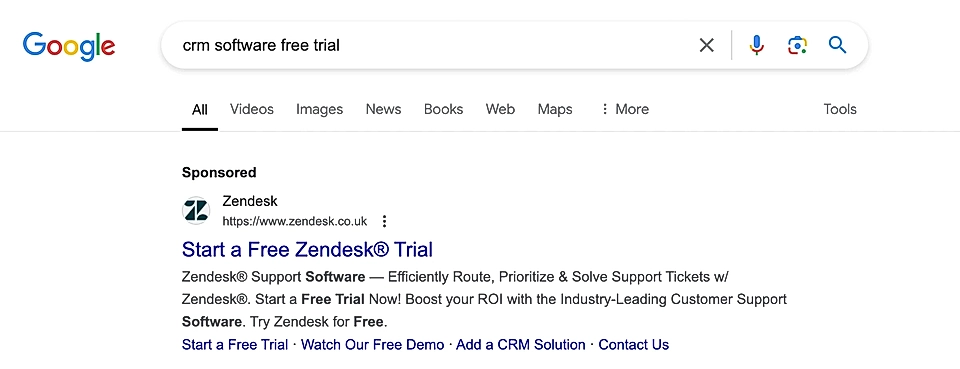
Are you starting to see the volume of landing pages your growing B2B SaaS needs? At LandingRabbit, we are looking to make it lightning-fast for B2B marketers like you to create landing pages for various search intents. Sign up for our 14-day free trial today and create SaaS landing pages without the back-and-forth and guesswork.
4. Remarketing isn’t straightforward
In B2C marketing, the social media channel matters – for example, you usually have different follower demographics on TikTok, Instagram, and Facebook.
And remarketing in B2C is powerful. Once you’ve visited an e-commerce site to buy a dress for a friend’s wedding, you can be sure to see closely matching ads in your social media feeds.
B2B marketers will need to understand the follower demographics and the best remarketing tactics in each channel, but because of the fully different discovery and buying process, retargeting everyone who visited certain pages doesn’t necessarily work.
For remarketing to bring results, you’ll need to match the buyer journey stage and the page visitor’s role in the buyer organization. For example, your prospect might share your landing page link with engineering and top leadership teams – if you’ve set up remarketing campaigns to show a “Sign up for free” banner across social media channels for those who visited, you won’t get as high clickthrough and conversion rate as you’d like.
What works on social media for B2B SaaS marketers?
Arguably, LinkedIn is one of the most efficient channels for B2B SaaS as it allows you to send direct messages to members and run targeted advertising campaigns based on a company, job title, function, geographic location, and much more. And obviously, your personal organic posts can be one of the best lead generation channels.
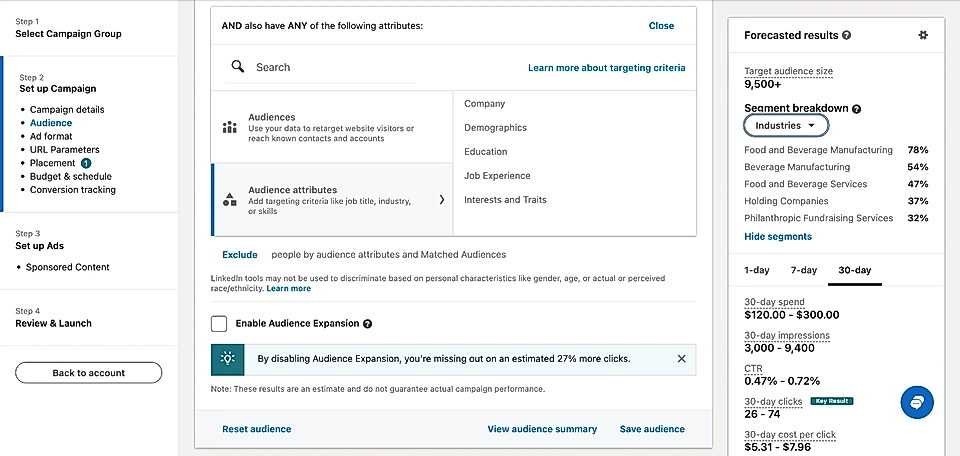
If you are clever when creating your newsletter subscription and lead magnet download forms, you’ll ask for the lead’s job role. While nobody likes long forms, your conversion rate will be wholly different if you are able to segment the newsletter content, call-to-actions, and landing page links based on the user’s role in the decision-making process.
YouTube is also one of the top choices of B2B SaaS marketers. While publishing videos regularly is time-consuming, one benefit is that you can easily narrow the content to a certain audience and ensure the quality of leads remains high. If you clearly communicate at the start of each video for who this is for, you will ensure that those who are not your ideal customers won’t stick around and click the landing page links.
5. Many decision-makers

Not only are your ideal customers often purchasing the solution on behalf of a team, but sometimes, you’ll need to convince multiple people in the buyer’s organization to get purchase approval.
For example, your customer might be an HR professional and using the software requires onboarding of the whole staff, a budget available this calendar year, help from the IT team, and approval from the data protection lead.
Just like in this fictional example, your SaaS will often need landing pages and content tailored to various decision-makers – people who might never log in to your product and, quite frankly, don’t necessarily care that much about your solution’s details.
Are you struggling to create high-converting landing pages for your B2B SaaS? At LandingRabbit, we aim to make it lightning-fast for you to create landing pages that perfectly match the user intent.
How can AI help improve message match for your B2B SaaS?
AI tools are a fantastic help for anyone who’s staring at a blank page, and there are many content optimization tools that every SaaS marketer should pay attention to.
Two areas where AI tools truly shine are dynamic pages and faster landing page generation.
Dynamic landing pages
Here are four examples of how dynamic landing pages can help your marketing efforts:
- Change the title of the landing page based on the ad campaign and keyword.
- Personalize based on user behaviour. For example, change the “You might also like” content suggestions based on previous page visits.
- Customize the page based on the user’s location.
- Create page variations and use Google Ads Experiments or A/B testing tools to dynamically serve a high-converting variation to website visitors.
For example, Figma could have created a dynamic page title, description, and CTA button for the "Whiteboard" page we took a look at earlier.

However, as we saw in the message match examples, dynamic content has its limitations. While it will almost certainly increase conversions if you match the page title with the ad campaign keyword, dynamic pages won’t save the average and bad experiences we are all painfully familiar with.
Faster landing page generation
The key reason why we are casualties of bad and average message matches is that B2B marketers don’t have enough time and resources to create landing pages for each buyer journey stage and user intent. As a result, B2B marketers waste their marketing budget (and page visitors’ time).
However, AI tools can significantly increase the landing page generation speed.
With a free ChatGPT or Claude account, you can write the landing page copy texts much faster than in the past. You can ask both models to help with the optimal landing page structure, too. Both Claude and ChatGPT accept document uploads, which they can use to create content that sounds like your tone of voice.
Grammarly will not only help you check for spelling and grammar errors but also suggests improvements based on your chosen style and tone of voice.
To make your copy more approachable for your design and developer team, consider using tools like Canva to create individual elements of the landing page. While far from perfect, wireframes with some of the visual elements showing the copy in situ will help your team create the final page.
In the future, Figma’s AI tools will help you create a decent mockup of a new website from scratch. Today, Elementor’s AI website builder is pretty good at creating page structure and look & feel based on your ideas – at least, you don’t need to start with a blank canvas.
At LandingRabbit, we are building tools that will combine the key capabilities of landing page copywriting, design, and implementation – removing the need for multiple AI tools and landing page builders. Sign up for our 14-day free trial and start creating high-converting B2B SaaS landing pages.